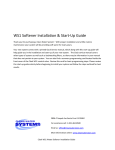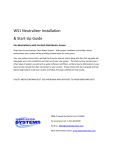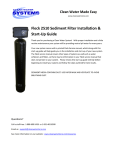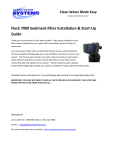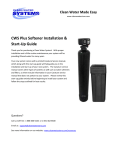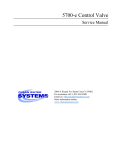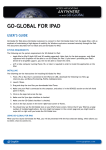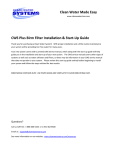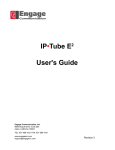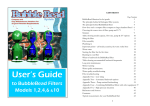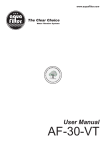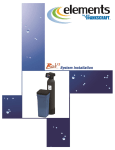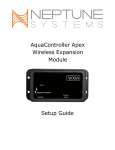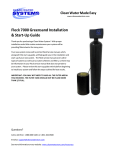Download Clack WS1 Pyrolox Installation & Start-Up Guide
Transcript
Clack WS1 Pyrolox Installation & Start‐Up Guide Thank you for purchasing a Clean Water System! With proper installation and a little routine maintenance your system will be providing treated water for many years. Your new system comes with a printed Clack Service manual, which along with this start‐up guide will help guide you in the installation and start‐up of your new system. The Clack service manual covers other types of systems as well such as water softeners and filters, so there may be information in your Clack service manual that does not pertain to your system. Please review this start‐up guide entirely before beginning to install your system and follow the steps outlined for best results. PYROLOX MEDIA CONTAINS DUST. USE PAPER MASK AND VENTILATE TO AVOID BREATHING DUST. 2806‐C Soquel Ave Santa Cruz CA 95062 For assistance call: 1‐831‐462‐8500 Email us: [email protected] More information online: www.cleanwaterstore.com Pre‐Installation 1. Review your packing list and make sure you have received all the parts before beginning installation. 2. If you are going to be turning off the water to the house and you have an electric water heater, shut off the power to the water heater before beginning installation in case water heater is accidentially drained. 3. Pick a suitable location for your filter system on a dry level spot where it won’t be exposed to freezing temperatures. A minimum of 20 PSI is required. Maximum pressure is 90 PSI. 4. Get all of your plumbing parts together before beginning installation. Installation typically takes 3 to 5 hours. However after installation the Pyrolox Filter must be allowed to run through a complete backwash and rinse cycle. 5. After the system is installed and running, your water may be discolored, or full of sediment or rust, particularly if this is older or corroded piping. Typically this clears up over a day or two. Best Practices for Piping & Drain Installation 1. See typical installation (see Fig 2, page 4). The Pyrolox filter is installed after the pressure tank. 2. Make sure to follow to connect the in pipe to the Clack WS1 inlet and the outlet to the outlet (see Fig 2). As you face the Clack WS1 control from the front, the water enters on the right and exits on the left. From the back (see Fig 2) the water enters on the left. The inlet and outlet are attached to the bypass valve which is marked with arrows as well. 3. Make sure there is a working gate or ball valve before the Clack WS1 Pyrolox filter and also one after as shown in the diagram Fig 2. The pressure gauges are optional and perhaps not necessary but a hose bib (which is a faucet that you can attach a garden hose to) is strongly recommended after the Pyrolox filter before the second ball valve. This makes it easy to rinse your new Pyrolox filter on start‐up and gives you a place to test the water before it enters your household plumbing. 4. If you will be using copper piping, do not sweat the copper pipe directly on to the Clack WS1 control valve. Avoid heating up the Clack WS1 control valve plastic with the torch. 5. You do not need unions to install your Clack WS1 control. If you need to remove it, the Clack WS1 has quick‐release couplings that make it easy to put the Pyrolox filter on by‐pass and remove the filter system from the piping. Page 2 Pyrolox WS1 Start‐Up Guide Clean Water Systems 2009 Rev 072609 6. The drain line tubing (not supplied) is connected to a drain from the drain outlet using flexible ½” ID tubing. Note that the drain can run up above the Clack WS1 control and into a drain, it does not have to drain down, as the filter backwashes under line pressure from your well pump. Most plumbing codes require an air‐gap connection, so that if your sewer or septic tank backs up, it cannot cross connect with the drain tubing. How Your Pyrolox Works See Fig 1. In your Pyrolox the water enters the top of the tank and flows down through the media and up the distributor tube. During backwash, the water flow is reversed and water flows down the distributor tube and up through the media, lifting and expanding the Pyrolox media and washing out rust and sediment to drain. During the backwash the Pyrolox is cleaned by the action of the water flowing through it so untreated well water can be used for backwashing. As a final cycle the Pyrolox is rinsed to drain by water flowing down through the media, up the distributor tube and to the drain. Note – the Pyrolox filter uses the Vortech distributor plate at the bottom, which comes pre‐installed in the filter tank. In some types of backwash filters such as calcite neutralizers and water softeners, no filter gravel is used with the Vortech distributor. However, with Pyrolox media, we do recommend some ¼” filter gravel be used and we include this with every order. Figure 1: Pyrolox media in tank Page 3 Pyrolox WS1 Start‐Up Guide Clean Water Systems 2009 Rev 072609 Figure 2 ‐Pyrolox Filter Tank Water Flow – Install Pyrolox filter after the pressure tank Page 4 Pyrolox WS1 Start‐Up Guide Clean Water Systems 2009 Rev 072609 Assembly and Installation Instructions 1. Unscrew by hand the entire Clack WS1 control valve from top of tank if it was shipped screwed on. Place distributor tube in tank if not already inside tank. If not already done, make sure blue cap is on top of distributor tube, or wrap the top of distributor tube with electrical or duct tape. You do not want gravel or Pyrolox media to go down the distributor tube. 2. Add filter gravel supplied first, using the funnel sent with the Pyrolox filter. 3. Next add Pyrolox. Tank should not be more than about 2/3rds or at most 3/4ths full. 4. Remove cap or tape from top of distributor tube. Be careful not to pull up distributor tube when removing cap or tape. 5. If possible at this point, fill tank completely with water. This will allow the Pyrolox media to settle and eliminate the need of “purging” the air out of the tank later. 6. Add a small amount of silicone grease or vegetable cooking oil to the tank threads and screw on Clack WS1 control valve carefully. Do not use pipe‐joint compound, Teflon tape, or Vaseline or other petroleum greases to lubricate tank threads. Figure 3: Pyrolox WS1 Control Valve Page 5 Pyrolox WS1 Start‐Up Guide Clean Water Systems 2009 Rev 072609 Figure 4: Installation Fittings 7. See Figure 4. If the O‐ring (3) and Split Ring (2) are not inserted correctly, the Nut (1) will not tighten. If the Nut doesn’t tighten up and is still loose when you go to connect the installation fitting assembly, then you know the O‐ring and Split Ring are not inserted correctly. 8. See Figure 5 on next page. If red valve handles are in‐line with pipe they are in service, not bypass. Move both valves to the BYPASS OPERATION position if not already in bypass. 9. Lubricate the by‐pass valve o‐rings with some vegetable oil or silicone grease and connect the bypass assembly to the Clack WS1 control by sliding the bypass valve firmly into the body of the Clack WS1. Once bypass is in far enough, you will be able to insert the red connector clips. 10. See by‐pass valves. If red valve handles are in‐line with pipe they are in service, not bypass. Move both valves to the bypass position if not already in bypass. 11. Now install your water pipes to the Clack WS1 bypass end connectors. (See Fig 3). Make sure inlet is installed to the 'In" pipe connector on the bypass valve and outlet is on the “Out” connector. Page 6 Pyrolox WS1 Start‐Up Guide Clean Water Systems 2009 Rev 072609 Figure 5: ByPass Valves 12. Connect some flexible tubing from the drain connection on the Clack WS1 control valve to a suitable drain such as a septic tank or drain to a sewer. It is OK to run the drain line up and over the Clack WS1 Pyrolox filter up to 6 feet above the top of the tank. If the drain line will be more than 20 feet, use larger diameter tubing such as ¾” or 1”. Note that it is desirable to be able to run the drain line into a bucket in order to test the backwash flow rate in the future. This is why hard piping the drain line is discouraged, however, if you do use hard PVC piping for the drain line, and you are able to remove the hard PVC drain piping and attach flexible tubing should you ever desire for testing purposes, it is OK to use rigid PVC pipe for the drain. Make sure the drain tubing is firmly clamped to the barbed fitting with a hose clamp to prevent leaks. 13. Plug in your Clack WS1 control valve to an outlet. Your Clack WS1 control valve is already pre‐ programmed. All you need to do is to set the time of day, and then set the number of days the Pyrolox filter will run before it backwashes automatically. The default number of days between back wash is 14, but it should be set to backwash at least once every 7 days. If you have a lot of sediment or rust, adjust the control to backwash every 3 to 4 days. Page 7 Pyrolox WS1 Start‐Up Guide Clean Water Systems 2009 Rev 072609 14. For programming your backwash filter, first set it to the real time of day using the up or down arrows. Then follow the steps below and set the filter to backwash every 7 days or less if the water has sediment or iron. If you have any difficulty programming it or see different values than what is shown below on this page, see Page 11 “OEM Filter System Setup Quick Reference” to set the control to the correct default settings for your filter. Page 8 Pyrolox WS1 Start‐Up Guide Clean Water Systems 2009 Rev 072609 15. The WS1 control has a leaflet located inside the control valve cover, please review this for information on how to set and program your control. It also comes with a manual that covers even more detail about the operation and function of the WS1 control valve. 16. Now you are ready to turn on the water. Turn on the water and leave the Pyrolox filter on bypass and check for leaks. Leave the ball valve after the Pyrolox filter closed, so water is still off to the house, but connect a garden hose and open up the hose bib after the Pyrolox filter and allow the water to run. This will help to clear out any foreign material that may be in the pipes from the piping installation. If you do not have a valve installed after the Pyrolox filter and you do not have a hose bib, you will need to turn the water on inside the house to let the water run. Use a bathtub or laundry sink or other fixture that does not have aerator screen. 17. Leave the water running out of the garden hose at a slow rate. 18. Press the REGEN button for several seconds which will start a manual backwash. 19. Now you can slowly turn the bypass valve to the service position. First open the Inlet Side of the bypass valve. Second slowly open the Outlet Side of the bypass until it is in the full service position. 20. There should be no Pyrolox media coming out of the drain line, but the water will be gray or dirty looking. At this point the Pyrolox will be in a backwash mode, which is the first of two cycles it goes through during backwash (also called regeneration”). The backwash takes 14 minutes. The next cycle is the rinse which takes 8 minutes. 21. After the backwash and rinse cycles are complete, repeat the process by pressing the REGEN button again for several seconds. 22. Note it is normal for some small amount of Pyrolox dust and fines to come out during the backwash, although you do not want to see a large amount of media coming out, which would mean you have very high water pressure, or the drain flow for the Clack WS1 is missing. 23. If possible verify that the backwash flow is 5 gallons per minute, which is the recommended backwash flow rate for 1.0 and 1.5 cubic foot models. If you have a 2.5 cubic foot Pyrolox it should be backwashing at 10 gallons per minute. You can easily run the drain hose to a bucket and using a watch verify the flow rate in gallons per minute. An adequate backwash is critical to properly clean the Pyrolox media and prevent it from cementing together. 24. Refer to your Clack WS1 service manual for more information about how your control valve is programmed if desired. Page 9 Pyrolox WS1 Start‐Up Guide Clean Water Systems 2009 Rev 072609 Maintaining Your WS1 Pyrolox Filter System There is little or no maintenance required. Every 6 – 10 years the Pyrolox media can be replaced for best results. Troubleshooting the Clack WS1 Pyrolox Filter One problem that may occur is if you do not have enough backwash flow rate to properly clean the Pyrolox filter. You can verify the backwash flow rate by running the drain line into a bucket and timing it when the Clack WS1 is in Cycle 1 or backwash. A 1.0 or 1.5 cubic foot system should have 5 gallons per minute and a 2.5 cubic foot system should have 10 gallons per minute of backwash. In some cases, the Clack WS1 may not be programmed correctly. See the Clack WS1 service manual for instructions on how to access the master programming. Page 10 Pyrolox WS1 Start‐Up Guide Clean Water Systems 2009 Rev 072609 Page 11 Pyrolox WS1 Start‐Up Guide Clean Water Systems 2009 Rev 072609











